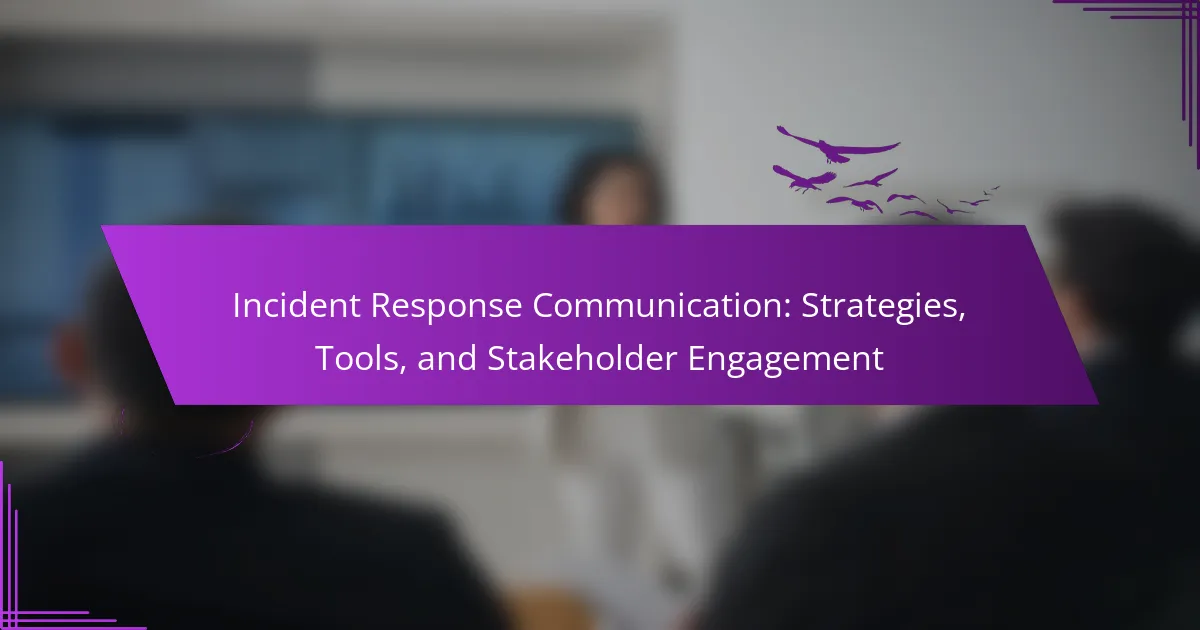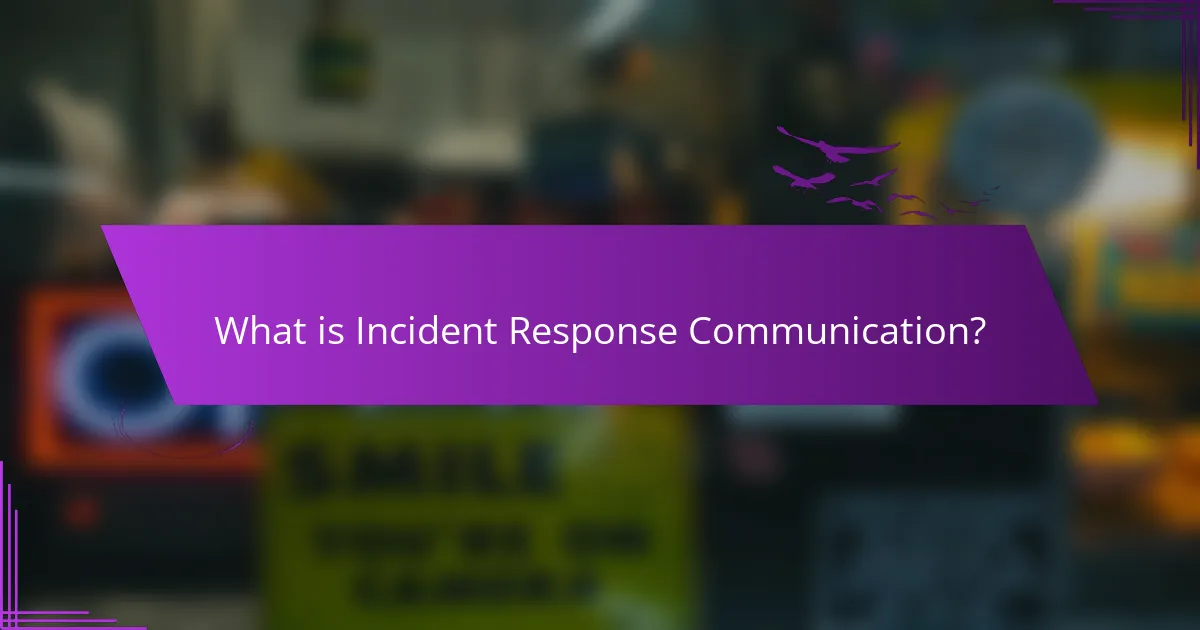
What is Incident Response Communication?
Incident Response Communication is the process of conveying information during and after a cybersecurity incident. It involves sharing details with stakeholders, including team members, management, and external parties. Effective communication helps manage the incident’s impact and ensures a coordinated response. Clear messaging is crucial for maintaining trust and transparency. Studies show that organizations with structured communication plans recover faster from incidents. Proper incident response communication can also mitigate reputational damage.
How does Incident Response Communication function in crisis situations?
Incident Response Communication functions in crisis situations by ensuring timely and accurate information dissemination. It involves clear messaging to stakeholders, including employees, customers, and media. Effective communication reduces confusion and helps manage public perception. It establishes a chain of command for information flow. This structure ensures that messages are consistent and coordinated. Regular updates are crucial to keep all parties informed. Utilizing various communication tools enhances reach and engagement. Research shows that organizations with strong communication strategies can recover faster from crises.
What are the key elements of effective Incident Response Communication?
The key elements of effective Incident Response Communication include clarity, timeliness, and audience awareness. Clarity ensures that messages are easily understood. Timeliness is crucial for providing information promptly during an incident. Audience awareness involves tailoring communication to the specific needs of different stakeholders. Additionally, consistency in messaging helps to avoid confusion. Feedback mechanisms allow for two-way communication, enabling adjustments as needed. Documentation of communication efforts supports accountability and future reference. These elements together enhance the overall effectiveness of incident response efforts.
How do communication protocols influence incident response outcomes?
Communication protocols significantly influence incident response outcomes by establishing clear guidelines for information exchange. Effective protocols ensure timely and accurate dissemination of information among stakeholders. This reduces response times and enhances coordination during incidents. Research indicates that organizations with structured communication protocols experience 30% faster resolution times. Furthermore, clear communication minimizes misunderstandings and errors, leading to more effective incident management. In contrast, poor communication can result in delays and increased damage during incidents. Thus, well-defined communication protocols are essential for successful incident response.
Why is Incident Response Communication critical for organizations?
Incident Response Communication is critical for organizations because it ensures timely and effective management of incidents. Clear communication helps coordinate response efforts among team members. It minimizes confusion and reduces the risk of errors during an incident. Effective communication also keeps stakeholders informed about the situation. This transparency builds trust and maintains organizational reputation. Studies show that organizations with strong communication strategies recover faster from incidents. For example, a report by the Ponemon Institute indicates that effective communication can reduce incident response time by up to 50%.
What are the potential consequences of poor communication during incidents?
Poor communication during incidents can lead to severe consequences. These include increased confusion among team members. Misunderstandings can result in delayed response times. Critical information may be lost or misinterpreted, worsening the situation. Stakeholders may feel uninformed or misled, damaging trust. Inadequate communication can also lead to inefficient resource allocation. Ultimately, these factors can escalate the incident’s impact, leading to greater harm or loss. Studies show that effective communication is vital in crisis management, as per the research by Coombs (2014) in “Ongoing Crisis Communication.”
How does effective communication enhance stakeholder trust?
Effective communication enhances stakeholder trust by fostering transparency and clarity. When stakeholders receive timely and accurate information, they feel informed and valued. This reduces uncertainty and builds confidence in the organization. Research shows that transparent communication can increase stakeholder satisfaction by up to 30%. Additionally, consistent messaging reinforces reliability. Stakeholders are more likely to trust organizations that communicate openly during incidents. This trust is crucial for maintaining long-term relationships and collaboration.
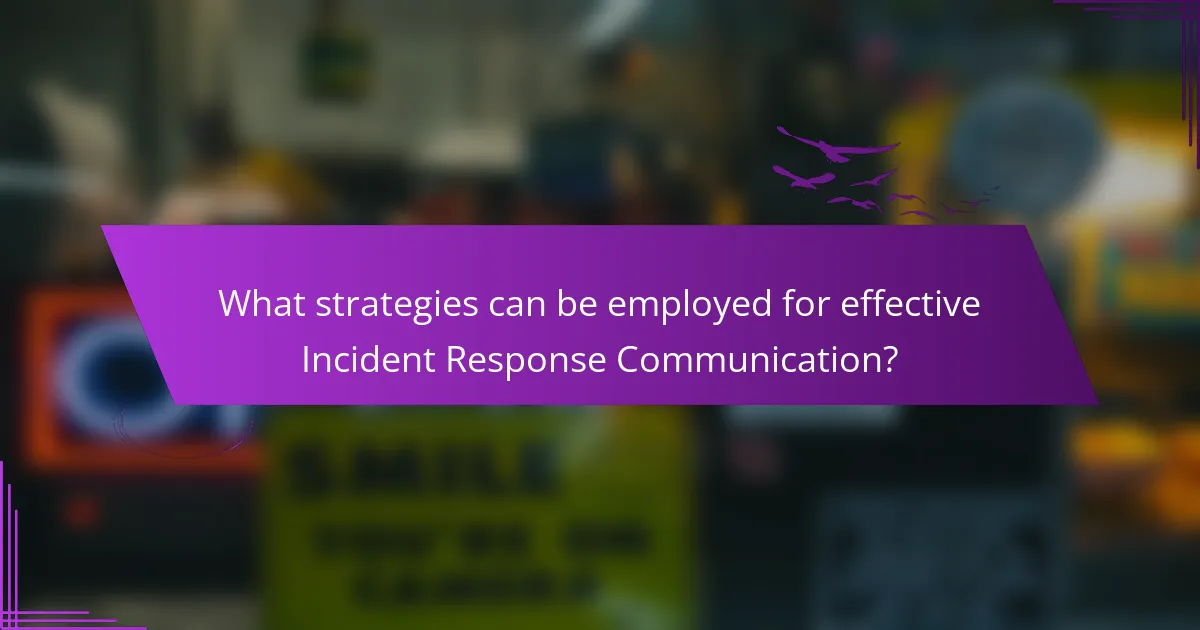
What strategies can be employed for effective Incident Response Communication?
Effective incident response communication strategies include clear messaging, timely updates, and designated spokespersons. Clear messaging ensures that all stakeholders understand the situation and response efforts. Timely updates keep stakeholders informed about developments and actions taken. Designated spokespersons help maintain consistency and credibility in communication. Utilizing multiple channels enhances reach and engagement. Regular training for the incident response team improves preparedness. Incorporating feedback mechanisms allows for adjustments based on stakeholder needs. These strategies collectively enhance the effectiveness of incident response communication.
How can organizations develop a communication plan for incident response?
Organizations can develop a communication plan for incident response by following a structured approach. First, they should identify key stakeholders and their roles during an incident. This includes internal teams, external partners, and affected customers. Next, organizations need to define clear communication objectives. These objectives should outline what information needs to be conveyed and the desired outcomes.
Then, organizations should establish communication channels. This includes selecting platforms for internal and external communication, such as email, social media, or dedicated incident response tools. After that, they must develop templates for different types of communication. These templates should cover initial notifications, updates, and final reports.
Additionally, organizations should conduct training sessions. These sessions ensure that all stakeholders understand their responsibilities and how to use the communication tools effectively. Regularly reviewing and updating the communication plan is also essential. This ensures that the plan remains relevant and effective in addressing potential incidents.
Finally, organizations should test the communication plan through drills. These exercises help identify gaps and areas for improvement. According to the National Institute of Standards and Technology (NIST), effective communication is crucial for successful incident response. Their guidelines emphasize the importance of preparedness and clear information sharing during incidents.
What components should be included in an incident response communication plan?
An incident response communication plan should include key components such as stakeholder identification, communication channels, message templates, and incident reporting procedures. Stakeholder identification ensures that all relevant parties are informed. Communication channels outline how information will be disseminated, such as email, SMS, or internal messaging systems. Message templates provide pre-approved responses for various scenarios, ensuring consistency. Incident reporting procedures detail how incidents will be documented and escalated. Furthermore, roles and responsibilities clarify who is accountable for communication tasks. Regular updates and feedback mechanisms should also be included to adapt to evolving situations. These components are essential for effective incident management and response.
How often should the communication plan be reviewed and updated?
The communication plan should be reviewed and updated at least annually. This frequency ensures that the plan remains relevant and effective. Changes in organizational structure, technology, or industry standards may necessitate updates. Regular reviews help identify gaps or areas for improvement. Stakeholder feedback should also be incorporated during these reviews. Additionally, after any significant incident, an immediate review is essential. This allows for lessons learned to be integrated into the plan. Regular updates enhance preparedness and response effectiveness.
What role does training play in Incident Response Communication strategies?
Training is essential in Incident Response Communication strategies. It equips team members with the necessary skills to communicate effectively during incidents. Training enhances understanding of roles and responsibilities within the communication framework. It fosters consistency in messaging, reducing the risk of misinformation. Regular drills and simulations improve response times and decision-making under pressure. Training also promotes collaboration among stakeholders, ensuring a unified approach. Research indicates that organizations with trained teams experience fewer communication failures during incidents. This highlights the importance of continuous training in maintaining effective incident response communication.
What types of training are most beneficial for incident response teams?
Incident response teams benefit most from hands-on simulation training. This training allows teams to practice real-world scenarios in a controlled environment. It enhances decision-making skills under pressure. Teams also benefit from technical skills training on specific tools and technologies. This ensures team members are proficient in using necessary software and hardware. Furthermore, communication training is crucial for effective collaboration during incidents. It helps team members convey information clearly and efficiently. Regular tabletop exercises also strengthen team dynamics and strategy development. These exercises encourage critical thinking and problem-solving in a group setting. Overall, a combination of these training types enhances the overall effectiveness of incident response teams.
How can simulations improve incident response communication skills?
Simulations can significantly improve incident response communication skills by providing realistic scenarios for practice. They allow responders to experience high-pressure situations without real-world consequences. This practice enhances decision-making and clarity in communication. Simulations encourage teamwork and collaboration among responders. Participants learn to convey critical information quickly and accurately. Feedback from simulations helps identify communication gaps. Studies show that regular simulation training leads to better preparedness. Effective communication during incidents directly correlates with successful outcomes.
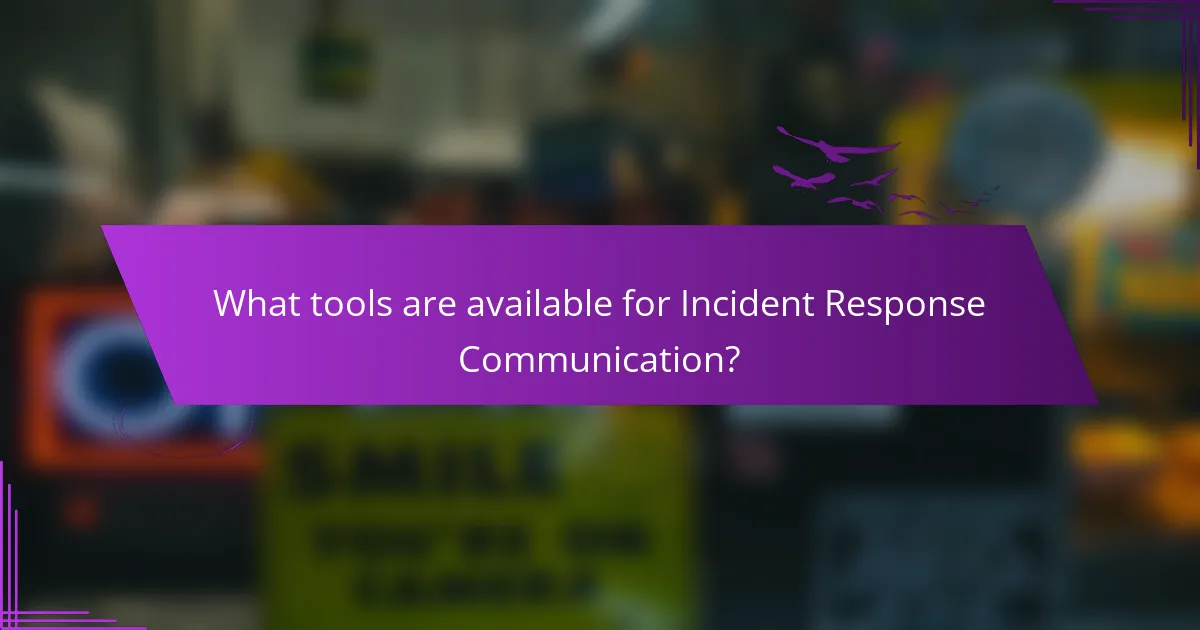
What tools are available for Incident Response Communication?
Tools available for Incident Response Communication include communication platforms, incident management software, and collaboration tools. Communication platforms like Slack or Microsoft Teams facilitate real-time messaging. Incident management software such as ServiceNow or PagerDuty helps track incidents and responses. Collaboration tools like Trello or Asana assist in organizing tasks and workflows. These tools enhance coordination among response teams. They also ensure timely updates to stakeholders during incidents. Effective communication is crucial for minimizing damage and restoring services quickly.
What types of communication tools are most effective during incidents?
Effective communication tools during incidents include instant messaging apps, email alerts, and dedicated incident management platforms. Instant messaging apps enable real-time communication among team members. Email alerts ensure critical updates reach all stakeholders promptly. Dedicated incident management platforms provide a centralized location for information sharing and tracking progress. According to a study by the National Institute of Standards and Technology, effective communication significantly enhances incident response efficiency. This highlights the importance of utilizing these tools during crisis situations.
How do collaboration platforms enhance incident response efforts?
Collaboration platforms enhance incident response efforts by facilitating real-time communication among stakeholders. These platforms enable instant sharing of information, which is critical during an incident. They allow teams to coordinate responses effectively, reducing the time to resolution. Centralized documentation of incidents improves accountability and traceability. Integration with other tools streamlines workflows, enhancing overall efficiency. Studies show that organizations using collaboration platforms can reduce incident response times by up to 30%. This efficiency leads to minimized impact on operations and improved recovery outcomes.
What are the advantages of using automated communication tools?
Automated communication tools enhance efficiency in incident response. They facilitate real-time information sharing, ensuring timely updates during crises. These tools reduce manual workload, allowing teams to focus on critical tasks. They also minimize human error, leading to more accurate communication. Automated notifications can reach stakeholders instantly, improving overall response time. According to a study by the Institute for Business Continuity Training, organizations using automated tools saw a 30% decrease in response times. This indicates a significant advantage in managing incidents effectively.
How can technology be leveraged to improve Incident Response Communication?
Technology can enhance Incident Response Communication through real-time information sharing. Tools like incident management software streamline communication among teams. These platforms enable centralized data access for all stakeholders. Mobile applications facilitate instant updates during incidents. Automated alerts ensure timely notifications to relevant parties. Collaboration tools support discussion and decision-making in real-time. Data analytics can identify communication gaps and improve future responses. According to a study by the National Institute of Standards and Technology, effective communication reduces incident response times significantly.
What role do mobile applications play in incident communication?
Mobile applications play a crucial role in incident communication by facilitating real-time information sharing. They enable users to receive alerts and updates instantly during incidents. Mobile apps can streamline communication among responders and stakeholders, ensuring coordinated efforts. Features like push notifications enhance the speed of information dissemination. According to a 2021 study by the National Institute of Standards and Technology, effective communication through mobile apps can significantly reduce response times. Furthermore, these applications often include features for reporting incidents, which helps in gathering data quickly. Overall, mobile applications enhance situational awareness and collaboration during incidents.
How can data analytics enhance communication strategies during incidents?
Data analytics can enhance communication strategies during incidents by providing real-time insights and data-driven decision-making. By analyzing data, organizations can identify key trends and patterns in incident occurrences. This enables them to tailor their communication to specific audiences effectively. Data analytics also helps in assessing the impact of communication efforts through feedback and engagement metrics. For example, metrics such as response times and audience reactions can be analyzed to refine messaging. Furthermore, predictive analytics can forecast potential incidents, allowing for proactive communication strategies. Research shows that organizations leveraging data analytics improve their incident response times by up to 30%. This demonstrates the significant value of data analytics in optimizing communication during critical situations.
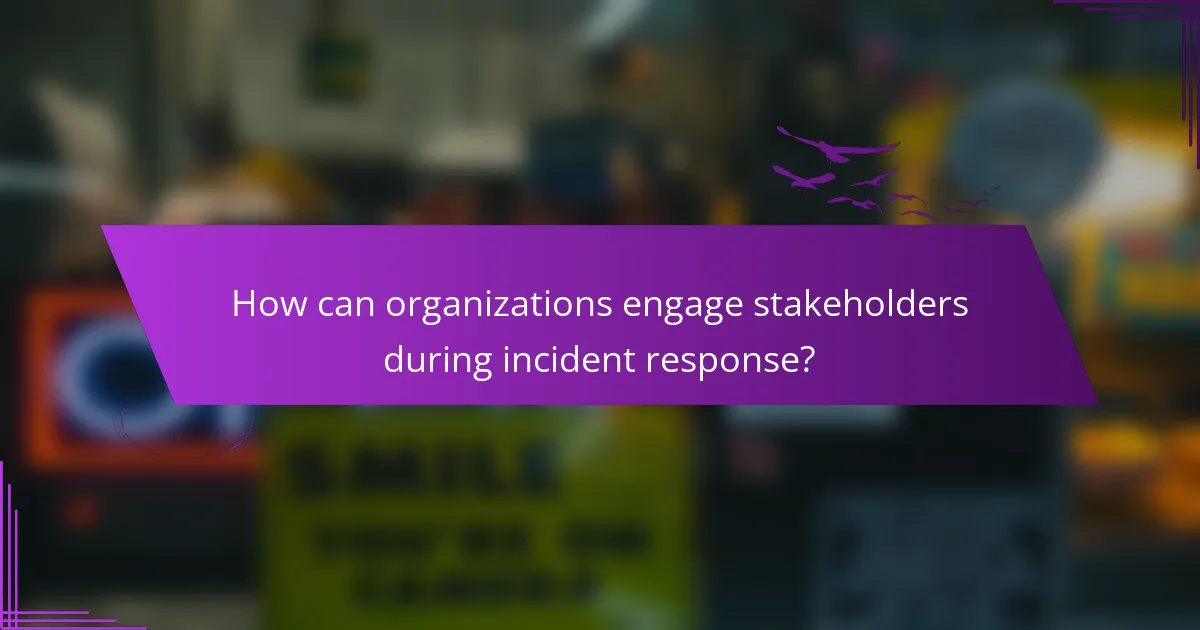
How can organizations engage stakeholders during incident response?
Organizations can engage stakeholders during incident response by establishing clear communication channels. Regular updates should be provided to stakeholders about the incident status. This can include details on the nature of the incident and the steps being taken to address it. Stakeholders should also be invited to participate in response planning. Engaging them in discussions can help gather valuable insights and feedback. Additionally, organizations can utilize digital platforms to facilitate real-time communication. Surveys or feedback forms can be distributed to assess stakeholder concerns. This approach fosters transparency and builds trust during the response process. Engaging stakeholders effectively can lead to improved incident management outcomes.
What are the best practices for stakeholder communication in incidents?
Best practices for stakeholder communication in incidents include timely updates, clear messaging, and designated communication channels. Timely updates ensure stakeholders receive information as events unfold. Clear messaging reduces confusion by providing straightforward, jargon-free language. Designated communication channels, such as email alerts or dedicated platforms, streamline information dissemination.
Regular status reports keep stakeholders informed of progress and next steps. Engaging stakeholders through feedback mechanisms fosters trust and collaboration. Post-incident reviews allow stakeholders to assess communication effectiveness and identify areas for improvement. According to a 2020 study by the National Institute of Standards and Technology, effective communication during incidents significantly enhances response outcomes.
How can transparency in communication affect stakeholder relationships?
Transparency in communication fosters trust among stakeholders. Trust leads to stronger relationships and better collaboration. When organizations share information openly, stakeholders feel valued and included. This inclusion enhances engagement and loyalty. Research indicates that transparent communication can reduce misunderstandings. According to a study by the Institute for Public Relations, transparency improves stakeholder perceptions of an organization. Improved perceptions lead to increased support during crises. Therefore, transparency is essential for effective stakeholder relationship management.
What methods can be used to gather stakeholder feedback post-incident?
Surveys and questionnaires are effective methods to gather stakeholder feedback post-incident. These tools allow stakeholders to provide structured input on their experiences. Interviews can also be conducted for more in-depth feedback. Focus groups facilitate discussion among stakeholders, yielding diverse perspectives. Additionally, feedback forms can be distributed immediately after the incident for timely responses. Online platforms enable real-time feedback collection. Analyzing social media comments can reveal stakeholder sentiment. Each method provides valuable insights for improving future incident responses.
What challenges do organizations face in engaging stakeholders during incidents?
Organizations face several challenges in engaging stakeholders during incidents. One significant challenge is communication breakdowns. These can occur due to unclear messaging or lack of timely updates. Stakeholders may feel uninformed or confused. Another challenge is varying stakeholder expectations. Different groups may have different priorities and concerns. This can lead to conflicting demands for information. Additionally, resource limitations can hinder effective engagement. Organizations may lack personnel or tools needed for comprehensive communication. Finally, emotional responses during incidents can complicate interactions. Stakeholders may react unpredictably, making it difficult to maintain constructive dialogue.
How can organizations overcome communication barriers with stakeholders?
Organizations can overcome communication barriers with stakeholders by implementing clear communication strategies. Establishing a common language is crucial for effective dialogue. Utilizing multiple communication channels can cater to diverse stakeholder preferences. Regular updates and transparent information sharing build trust and understanding. Training staff in effective communication techniques enhances message clarity. Feedback mechanisms allow stakeholders to voice concerns and ask questions. Active listening fosters a collaborative environment. Research indicates that organizations with strong communication practices have 47% higher returns to shareholders (McKinsey & Company).
What strategies can help manage stakeholder expectations during an incident?
Clear and timely communication is essential to manage stakeholder expectations during an incident. Establish a communication plan that outlines who will communicate, what information will be shared, and when updates will occur. Regular updates help stakeholders feel informed and involved. Use multiple channels, such as emails, meetings, and social media, to reach diverse stakeholders effectively. Acknowledge the incident’s impact transparently, providing realistic assessments of the situation. Set achievable timelines for resolution to prevent overpromising. Engage stakeholders in the decision-making process to foster collaboration and trust. Document all communications for accountability and future reference. These strategies have been proven effective in various incident management frameworks, such as the National Incident Management System (NIMS).
What are the key takeaways for effective Incident Response Communication?
Key takeaways for effective Incident Response Communication include clarity, timeliness, and audience awareness. Clear communication ensures that all stakeholders understand the situation. Timeliness is crucial; information should be shared as soon as it is available. Understanding the audience helps tailor messages to their needs and concerns. Regular updates maintain engagement and trust. Utilizing multiple channels ensures wider reach. Documenting communication improves future responses and accountability. These strategies enhance overall incident management effectiveness.
How can organizations implement lessons learned from past incidents?
Organizations can implement lessons learned from past incidents by establishing a formal review process. This process should involve gathering data from the incident, including what occurred and the response actions taken. Teams should analyze the data to identify strengths and weaknesses in their response.
Documentation of findings is essential for future reference. Organizations should create reports that summarize the lessons learned and distribute them among relevant stakeholders. Training sessions can be organized to educate employees on the insights gained from past incidents.
Regularly updating response plans based on these lessons ensures continuous improvement. According to a study by the National Institute of Standards and Technology, organizations that analyze past incidents improve their response effectiveness by up to 50%. This structured approach enhances overall incident response capabilities.
What are the top tips for improving communication during incident response?
Establish clear communication channels to enhance incident response efficiency. Use predefined protocols to ensure all team members understand their roles. Regularly update stakeholders to maintain transparency about the incident status. Implement a centralized communication tool for real-time updates and collaboration. Conduct post-incident reviews to identify communication gaps and improve future responses. Train team members on effective communication strategies to foster collaboration. Utilize visual aids like flowcharts to clarify processes during incidents. Encourage feedback from team members to refine communication practices continuously.
Incident Response Communication refers to the structured process of conveying information during and after cybersecurity incidents. This article examines the critical components of effective incident response communication, including clarity, timeliness, and stakeholder engagement. It outlines strategies for developing communication plans, the role of training and technology, and the importance of stakeholder feedback. Additionally, the article discusses the potential consequences of poor communication and highlights best practices for maintaining transparency and trust among stakeholders during crises.
